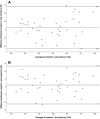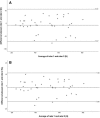Reliability and validity of knee extensor strength measurements using a portable dynamometer anchoring system in a supine position
- PMID: 31286912
- PMCID: PMC6615264
- DOI: 10.1186/s12891-019-2703-0
Reliability and validity of knee extensor strength measurements using a portable dynamometer anchoring system in a supine position
Abstract
Background: Muscle strength measurements using hand-held dynamometry (HHD) can be affected by the inadequate strength of the tester and lack of stabilization of the participants and the device. A portable HHD anchoring system was designed that enabled the measurement of isometric knee extensor muscle strength in a supine position. This can be used with individuals who are unable to assume the sitting position required for the measurement of knee extensor strength in conventional isokinetic dynamometry (IKD). The aim of this study was to evaluate the reliability and validity of knee extensor strength measurements using this device.
Methods: The maximal knee extensor isometric strength of the dominant leg in healthy adults aged 20 to 40 years was tested. Three trials of three contractions were assessed by two raters using the portable dynamometer anchoring system whilst the participant was in the supine position. After the three measurement trials, peak knee extensor torque was evaluated using IKD. The intraclass correlation coefficient (ICC) and 95% limits of agreement (LOA) for intra- and inter-rater reliability were obtained.
Results: Thirty-nine participants (19 male and 20 female, aged 30.08 ± 4.16 y), completed the three measurement trials. The ICC for intra-rater reliability was 0.98 for the maximum measurements of knee extensor strength (95% confidence interval [CI]: 0.96-0.98) and 0.98 (95% CI: 0.96-0.99) for inter-rater reliability. The mean difference (%) between the maximum knee extensor strength measurements of each trial was 1.02% (LOA range: - 11.13 to 13.16%) for intra-rater and - 1.44% (LOA range: - 13.98 to 11.08%) for inter-rater measurements. The Pearson correlation coefficient of the maximum voluntary peak torque measurements with the portable dynamometer anchoring system and IKD was 0.927.
Conclusions: The portable dynamometer anchoring system is a reliable and valid tool for measuring isometric knee extensor strength in a supine position. Future clinical feasibility studies are needed to determine if this equipment can be applied to people with severe illness or disabilities.
Trial registration: KCT0003041 .
Keywords: Hand-held dynamometry; Portable dynamometer anchoring system; Supine.
Conflict of interest statement
The authors declare that they have no competing interests.
Figures




Similar articles
-
Development and validation of a portable articulated dynamometry system to assess knee extensor muscle strength.Sci Rep. 2023 Jul 23;13(1):11887. doi: 10.1038/s41598-023-39062-0. Sci Rep. 2023. PMID: 37482569 Free PMC article.
-
Test-retest reliability and concurrent validity of knee extensor strength measured by a novel device incorporated into a weight stack machine vs. handheld and isokinetic dynamometry.PLoS One. 2024 May 22;19(5):e0301872. doi: 10.1371/journal.pone.0301872. eCollection 2024. PLoS One. 2024. PMID: 38776288 Free PMC article.
-
Knee Extensor Strength Measurement in Patients With Limited Physical Activity Using a Supine Dynamometer Anchoring Frame.Ann Rehabil Med. 2020 Dec;44(6):502-509. doi: 10.5535/arm.20056. Epub 2020 Dec 31. Ann Rehabil Med. 2020. PMID: 33440098 Free PMC article.
-
Can Clinicians Trust Objective Measures of Hip Muscle Strength From Portable Dynamometers? A Systematic Review With Meta-analysis and Evidence Gap Map of 107 Studies of Reliability and Criterion Validity Using the COSMIN Methodology.J Orthop Sports Phys Ther. 2023 Nov;53(11):655-672. doi: 10.2519/jospt.2023.12045. J Orthop Sports Phys Ther. 2023. PMID: 37787581
-
Evaluation isometric and isokinetic of trunk flexor and extensor muscles with isokinetic dynamometer: A systematic review.Phys Ther Sport. 2020 Sep;45:93-102. doi: 10.1016/j.ptsp.2020.06.008. Epub 2020 Jul 17. Phys Ther Sport. 2020. PMID: 32726732
Cited by
-
Problems in Diagnosis and Treatment of Soleus Muscle Injuries-Narrative Review and Case Report.J Clin Med. 2025 Mar 13;14(6):1955. doi: 10.3390/jcm14061955. J Clin Med. 2025. PMID: 40142763 Free PMC article. Review.
-
A portable articulated dynamometer for ankle dorsiflexion and plantar flexion strength measurement: a design, validation, and user experience study.Sci Rep. 2023 Dec 14;13(1):22221. doi: 10.1038/s41598-023-49263-2. Sci Rep. 2023. PMID: 38097727 Free PMC article.
-
Development and validation of a portable articulated dynamometry system to assess knee extensor muscle strength.Sci Rep. 2023 Jul 23;13(1):11887. doi: 10.1038/s41598-023-39062-0. Sci Rep. 2023. PMID: 37482569 Free PMC article.
-
Indirect calorimetry directed feeding and cycling in the older ICU population: a pilot randomised controlled trial.BMC Anesthesiol. 2024 May 7;24(1):171. doi: 10.1186/s12871-024-02507-8. BMC Anesthesiol. 2024. PMID: 38714926 Free PMC article. Clinical Trial.
-
Establishing Reference Values for Isometric Knee Extension and Flexion Strength.Front Physiol. 2021 Oct 15;12:767941. doi: 10.3389/fphys.2021.767941. eCollection 2021. Front Physiol. 2021. PMID: 34721087 Free PMC article. Review.
References
-
- Hairi NN, Cumming RG, Naganathan V, Handelsman DJ, Le Couteur DG, Creasey H, et al. Loss of muscle strength, mass (sarcopenia), and quality (specific force) and its relationship with functional limitation and physical disability: the Concord health and ageing in men project. J Am Geriatr Soc. 2010;58(11):2055–2062. doi: 10.1111/j.1532-5415.2010.03145.x. - DOI - PubMed
Publication types
MeSH terms
Grants and funding
LinkOut - more resources
Full Text Sources

